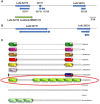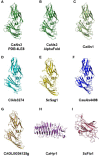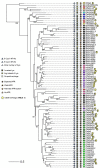Using Genomics to Shape the Definition of the Agglutinin-Like Sequence (ALS) Family in the Saccharomycetales
- PMID: 34970511
- PMCID: PMC8712946
- DOI: 10.3389/fcimb.2021.794529
Using Genomics to Shape the Definition of the Agglutinin-Like Sequence (ALS) Family in the Saccharomycetales
Abstract
The Candida albicans agglutinin-like sequence (ALS) family is studied because of its contribution to cell adhesion, fungal colonization, and polymicrobial biofilm formation. The goal of this work was to derive an accurate census and sequence for ALS genes in pathogenic yeasts and other closely related species, while probing the boundaries of the ALS family within the Order Saccharomycetales. Bioinformatic methods were combined with laboratory experimentation to characterize 47 novel ALS loci from 8 fungal species. AlphaFold predictions suggested the presence of a conserved N-terminal adhesive domain (NT-Als) structure in all Als proteins reported to date, as well as in S. cerevisiae alpha-agglutinin (Sag1). Lodderomyces elongisporus, Meyerozyma guilliermondii, and Scheffersomyces stipitis were notable because each species had genes with C. albicans ALS features, as well as at least one that encoded a Sag1-like protein. Detection of recombination events between the ALS family and gene families encoding other cell-surface proteins such as Iff/Hyr and Flo suggest widespread domain swapping with the potential to create cell-surface diversity among yeast species. Results from the analysis also revealed subtelomeric ALS genes, ALS pseudogenes, and the potential for yeast species to secrete their own soluble adhesion inhibitors. Information presented here supports the inclusion of SAG1 in the ALS family and yields many experimental hypotheses to pursue to further reveal the nature of the ALS family.
Keywords: ALS genes; adhesion; comparative genomics; fungi; protein structure; repeated sequences.
Copyright © 2021 Oh, Schliep, Isenhower, Rodriguez-Bobadilla, Vuong, Fields, Hernandez and Hoyer.
Conflict of interest statement
The authors declare that the research was conducted in the absence of any commercial or financial relationships that could be construed as a potential conflict of interest.
Figures






Similar articles
-
Agglutinin-Like Sequence (ALS) Genes in the Candida parapsilosis Species Complex: Blurring the Boundaries Between Gene Families That Encode Cell-Wall Proteins.Front Microbiol. 2019 Apr 26;10:781. doi: 10.3389/fmicb.2019.00781. eCollection 2019. Front Microbiol. 2019. PMID: 31105652 Free PMC article.
-
Characterization of agglutinin-like sequence genes from non-albicans Candida and phylogenetic analysis of the ALS family.Genetics. 2001 Apr;157(4):1555-67. doi: 10.1093/genetics/157.4.1555. Genetics. 2001. PMID: 11290712 Free PMC article.
-
Discovering the secrets of the Candida albicans agglutinin-like sequence (ALS) gene family--a sticky pursuit.Med Mycol. 2008 Feb;46(1):1-15. doi: 10.1080/13693780701435317. Med Mycol. 2008. PMID: 17852717 Free PMC article. Review.
-
Characterization of the Candida orthopsilosis agglutinin-like sequence (ALS) genes.PLoS One. 2019 Apr 24;14(4):e0215912. doi: 10.1371/journal.pone.0215912. eCollection 2019. PLoS One. 2019. PMID: 31017950 Free PMC article.
-
The Candida albicans agglutinin-like sequence family of adhesins: functional insights gained from structural analysis.Future Microbiol. 2015;10(10):1635-548. doi: 10.2217/fmb.15.79. Epub 2015 Oct 6. Future Microbiol. 2015. PMID: 26438189 Review.
Cited by
-
Peering Into Candida albicans Pir Protein Function and Comparative Genomics of the Pir Family.Front Cell Infect Microbiol. 2022 Mar 18;12:836632. doi: 10.3389/fcimb.2022.836632. eCollection 2022. Front Cell Infect Microbiol. 2022. PMID: 35372132 Free PMC article.
-
Parallel expansion and divergence of an adhesin family in pathogenic yeasts.Genetics. 2023 Apr 6;223(4):iyad024. doi: 10.1093/genetics/iyad024. Genetics. 2023. PMID: 36794645 Free PMC article.
-
Development and Use of a Monoclonal Antibody Specific for the Candida albicans Cell-Surface Protein Hwp1.Front Cell Infect Microbiol. 2022 Jun 27;12:907453. doi: 10.3389/fcimb.2022.907453. eCollection 2022. Front Cell Infect Microbiol. 2022. PMID: 35832385 Free PMC article.
-
Development and validation of monoclonal antibodies specific for Candida albicans Als2, Als9-1, and Als9-2.PLoS One. 2022 Jul 8;17(7):e0269681. doi: 10.1371/journal.pone.0269681. eCollection 2022. PLoS One. 2022. PMID: 35802580 Free PMC article.
-
A Candida auris-specific adhesin, Scf1, governs surface association, colonization, and virulence.Science. 2023 Sep 29;381(6665):1461-1467. doi: 10.1126/science.adf8972. Epub 2023 Sep 28. Science. 2023. PMID: 37769084 Free PMC article.
References
-
- Bailey D. A., Feldmann P. J., Bovey M., Gow N. A., Brown A. J. (1996). The Candida albicans HYR1 Gene, Which is Activated in Response to Hyphal Development, Belongs to a Gene Family Encoding Yeast Cell Wall Proteins. J. Bacteriol. 178, 5353–5360. doi: 10.1128/jb.178.18.5353-5360.1996 - DOI - PMC - PubMed
-
- Bertini A., Zoppo M., Lombardi L., Rizzato C., De Carolis E., Vella A., et al. . (2016). Targeted Gene Disruption in Candida parapsilosis Demonstrates a Role for CPAR2_404800 in Adhesion to a Biotic Surface and in a Murine Model of Ascending Urinary Tract Infection. Virulence 7, 85–97. doi: 10.1080/21505594.2015.1112491 - DOI - PMC - PubMed
Publication types
MeSH terms
Substances
Grants and funding
LinkOut - more resources
Full Text Sources
Molecular Biology Databases
Research Materials
Miscellaneous

